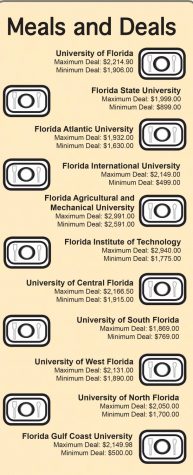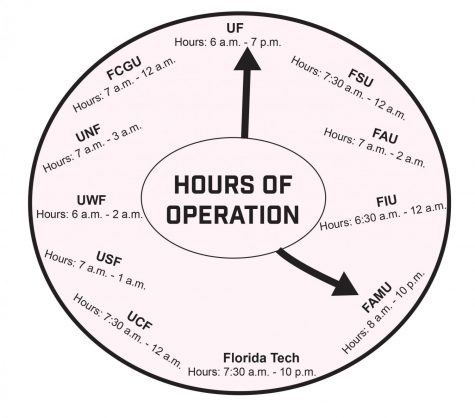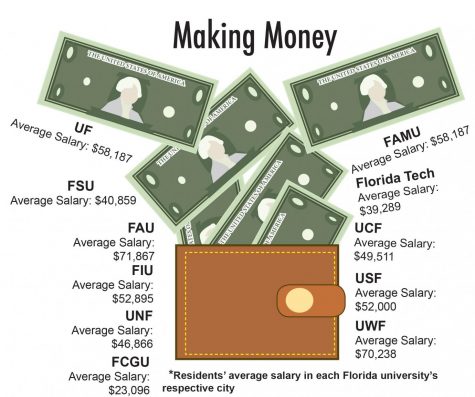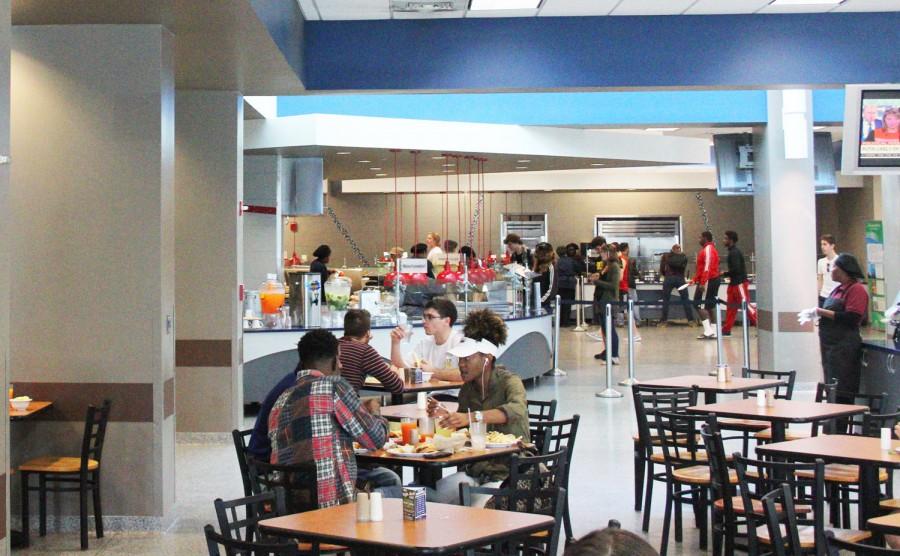Campus food costs around the state
As registration for spring classes begins, students express their frustrations over campus food costs.
November 19, 2017
While students gear up for their spring semester classes, they’re also renewing their meal plans. But many students complain that the meal plan is too costly for what it offers and that even the options outside of campus don’t cater to students, leaving some to worry where they’ll find food.
The cost of the most expensive FAU meal plan currently stands at $1,932 for residents, with the least expensive coming in at $1,630. When including the cost of tuition, a student can spend upward of $4,648 per semester on just food and classes alone.
The average monthly cost for groceries for males between the ages of 19-50 costs $368.80, according to the United States Department of Agriculture. For females, the costs stand at $327.20.
The FAU meal plan, spread out over the length of a semester, averages out to $408-483 per month.
Licensed dietitian Wendy Dickerman said that while the USDA’s food guidelines are an accurate measurement of what a person pays per month for food, it doesn’t take into account additional food costs and general costs of living.
“Those numbers don’t take into consideration is that buying items like milk, bread, yogurt, meat, peanut butter, jelly, whatever you need at that moment,” she said. “It also doesn’t take into account cooking the food and adding herbs and spices that you need to cook.”
Dickerman said that buying groceries and eating out will cost more in wealthy areas like Boca Raton.

“Food is going to expensive in a place like Boca than in rural Wisconsin,” she said.
The dietitian added that the cost of food isn’t the only factor taken into account when FAU calculates meal plan costs. Chartwells, the company that operates all food services at FAU, has to cover the costs of food, maintenance, and employee salary.
“When you look at a meal plan, you have to take into account that someone is cooking it for you, you have to pay for a cook, someone to clean the floors, you have to pay someone to clean the ovens,” she said.
The University Press requested to speak with Chartwells about on-campus food prices but the company did not respond as of publication time.
The average cost of an inexpensive restaurant meal in Boca Raton is $17.50, according to cost-of-living database Numbeo. In Gainesville and Tallahassee, where the University of Florida and Florida State University are located respectively, an average “inexpensive” meal costs $11.
Near the University of South Florida’s main campus in Tampa, the average cost of a restaurant meal is $13.50.

With the cost of the current FAU meal plan and Boca’s high cost of living, many students are seeking alternative options.
Senior sociology major Yuval Pritz said that the cafeteria food isn’t worth the cost that the school issues for the meal plan. Despite this, she still ends up spending close to $500 on food from the Breezeway food court and Boca takeout every month.
“It’s not quality food at the cafe and it’s only quality when orientation comes by so that’s maybe the days I would go to the cafe,” she said.
As a commuter, Pritz said that even takeout and food court meals are expensive and put a strain on her finances.
“The [food court] quality isn’t the best and there aren’t that many options,” Pritz said. “Sometimes I have to order delivery or I don’t eat for the day.”

Junior communication major Flaviane Chavez said that as a resident, she’s no longer required to have a meal plan, but during her freshman year, she frequently ate at the food court to avoid the cafeteria food.
“I used to always get a bagel in the morning … three times a week so I would spend around $2, $6. If I was here all day, I could easily see myself spending $10 a day and I was here three times a week so around $30,” she said.
Chavez said that the Wendy’s located in the food court, the Subway near FAU Stadium, and the Chick-fil-A located near the Wimberly Library are the only places where she can eat on a budget. She also added that Outtakes items seem to cost too much for what they offer.
“I feel like the price over there is super inflated,” Chavez said. “It’s almost like price gouging during hurricane season, even the bookstore food is expensive, especially if you’re looking for snacks.”
The communication major said that going out to eat isn’t much of an option as well due to parking and time. Chavez said that getting food off campus would mean fighting for parking all over again.

Senior psychology major Valeria Castro and Ph.D. mathematics student Daniel Grey said that they don’t stay on campus enough to warrant having a meal plan. And while they eat at the food court because it fits their budget, they aren’t usually impressed.
“I mainly do Chick-fil-A and the Chick-N-Grill and Wendy’s. In general, the quality is crap,” Castro said.
“I just buy the sandwiches from Outtakes,” Grey added.
Both students say that paying for on-campus food is a hassle. Castro said that between paying for Starbucks in the morning and leaving in the afternoon, she spends $15-$20 a day eating on campus.
With her schedule sitting around three to five class meetings per week, she spends around $60-$100 buying food on campus.
Grey said that there are options that are cheaper than what the school has to offer but due to the distance and his concern over being able to find parking again, he’s forced to go to Outtakes.
“There’s probably a … convenience store that sells sandwiches for cheaper than here but it’s an hour and a half away,” the Ph.D. student said.
He added, “It’s like going to a gas station that knowingly rips you off and you can’t do anything about it.”
Nate Nkumbu is a staff writer for the University Press. For information regarding this or other stories, email [email protected] or tweet him @FoureyedNate.






